
RS Models 1/72 Ar-65
| KIT #: | ? |
| PRICE: | $16.98 |
| DECALS: | options |
| REVIEWER: | Carmel J. Attard |
| NOTES: |

| HISTORY |
Although the Arado 65 is not as well known and popular
aircraft as the Bf109 it also had an interesting origin and history. The Ar 65
was a prewar German biplane, which flew with BMW VI engine as a first prototype
fighter. The engine gave a normal rating of
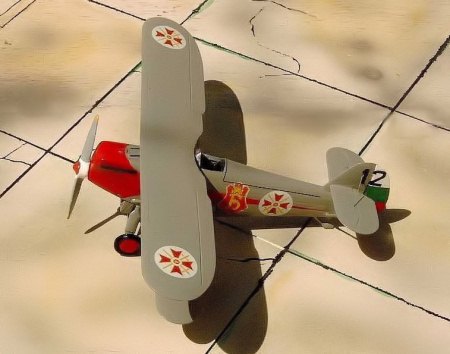 500hp. Two subsequent prototypes
introduced a number of modifications to the basic designed the Ar 65d that
joined the programme in 1932 was markedly improved both in handling and
performance. Eventually the German RLM instructed the Arado Company to prepare
for series production for use by the so-called Reklamefliegerabteilung.
500hp. Two subsequent prototypes
introduced a number of modifications to the basic designed the Ar 65d that
joined the programme in 1932 was markedly improved both in handling and
performance. Eventually the German RLM instructed the Arado Company to prepare
for series production for use by the so-called Reklamefliegerabteilung.
Further minor modifications were carried out and the biplane fighter entered production at Warnemunde as the Ar 65e, which was armed with two 7.9mm MG17 machine guns mounted on the nose ahead of the cockpit. The Reklamme-Staffel, which was to be officially designated JG/132 and later JG/2 in March 1935, began to receive the Heinkel He-51. For some time both types of biplane operated alongside each other until in 1935 the Arado Ar 65 transferred to the DVS Jagdfliegerschule at Schliessheim to serve in the fighter-training role. From early in the war the Ar 65 were used by the Luftwaffe in training role at Olmutz, Prostnitz and Pilsen. During the period from 1942-43 they were used by Erganzungs-Schleppgruppen 1 and 2 to tow DFS 230 gliders for carrying troops from Kuban bridgehead in Russia. The Arado 65 had a span of 11.2m; length of 8.4m; weight of 1,915kg and had a maximum speed of 300 Km/hr and a ceiling of 7,600 m
The Ar 65 in Bulgarian service
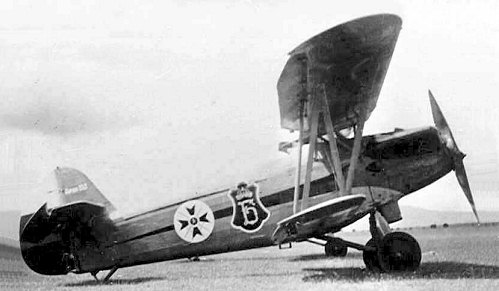 In 1937
several Ar 65 were sold to Bulgaria for use in the training role. These were
referred to Ar 65F Orel (Eagle), and served with the second fighter
Orlyak (Wing) that was based at Korlove in Bulgaria. The wing consisted of five
Yato (Training Squadrons) and an aerobatic school. The training squadrons had
several types of aircraft, including the Avia B 534s, Avia B 122s, He 51s and Bu
131s and among these were the 12 Arado 65F biplanes. These were also among a
large assorted consignment of military aircraft totaling 203 in number that the
German RLM supplied to Bulgaria between 1936 and 1941. Needless to say that this
was then a step in the right direction for Bulgaria towards the creation of a
capable and active air force.
In 1937
several Ar 65 were sold to Bulgaria for use in the training role. These were
referred to Ar 65F Orel (Eagle), and served with the second fighter
Orlyak (Wing) that was based at Korlove in Bulgaria. The wing consisted of five
Yato (Training Squadrons) and an aerobatic school. The training squadrons had
several types of aircraft, including the Avia B 534s, Avia B 122s, He 51s and Bu
131s and among these were the 12 Arado 65F biplanes. These were also among a
large assorted consignment of military aircraft totaling 203 in number that the
German RLM supplied to Bulgaria between 1936 and 1941. Needless to say that this
was then a step in the right direction for Bulgaria towards the creation of a
capable and active air force.
The formal rebirth of the Bulgarian Air Force took place on Sunday 27th June 1937 at Bojourishte Airfield that is close to Sofia. On that day His Majesty King Boris III handed over VNVV Standard of the four newly formed wings as he donated the 12 Arado Ar 65 and 12 Dornier So 11 Bats. The Arado was primarily intended to be used as fighters. These were paid from the King’s own pocket. Hence it was for this reason that both the Arado 65s and the Do 11s lavishly displayed King Boris III’s own cipher, consisting of a red shield over which was painted a stylized letter B in yellow appearing on the fuselage and tail fin respectively. The Arado Ar 65 were eventually used as advanced and continuation trainers. Like the He 51that was serving alongside the Arado, they were powered by BMW 750 engine.
 In spite of its graceful biplane design, the Ar 65 was never
particularly well liked by its crew for their handling qualities, but they
aremain known for being the aircraft that broke the hated restrictions of the Neuilly treaty of 27th November 1919, the Treaty of peace between the
Allied and Associated Powers and Bulgaria and Protocol and| Declaration signed
at Neuilly-sur-Seine. That treaty went back to 1919 when after being defeated in
WWI, Bulgaria under the agreed terms had been legally prevented for two decades
from possessing an air force. In 1932 the Thassaliniki Treaty between Britain,
Bulgaria and France finally abolished the Paris Treaty’s limitations on
Bulgaria’s military aviation.
In spite of its graceful biplane design, the Ar 65 was never
particularly well liked by its crew for their handling qualities, but they
aremain known for being the aircraft that broke the hated restrictions of the Neuilly treaty of 27th November 1919, the Treaty of peace between the
Allied and Associated Powers and Bulgaria and Protocol and| Declaration signed
at Neuilly-sur-Seine. That treaty went back to 1919 when after being defeated in
WWI, Bulgaria under the agreed terms had been legally prevented for two decades
from possessing an air force. In 1932 the Thassaliniki Treaty between Britain,
Bulgaria and France finally abolished the Paris Treaty’s limitations on
Bulgaria’s military aviation.
Other places from where the Arado 65 operated apart from Korlove were Kazanluk Airfield where the 1st and 2nd Training Air School was located. In Kazanluk there was the Bulgarsi Kaproni Aeroplane Factory where circa 1931 was producing another important trainer biplane –the KB2 UT.
| THE KIT |
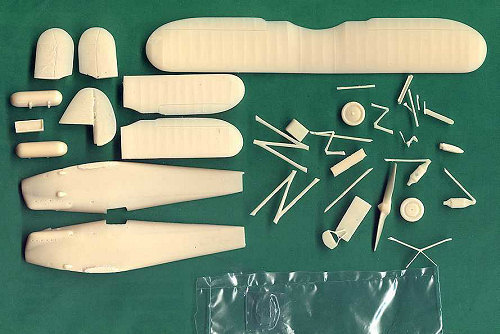 In order
to cover at least two of the variety of schemes that the Arado 65 appeared in
during its service with the Royal Bulgarian Air Force I needed two scale models.
The first scale model built came from RS, the Czech Republic kit manufacturer
that produces the kit out of resin. The Ar 65 comes in a soft cardboard box with
colourful artwork on the cover, a highly detailed painting of a Luftwaffe Arado
65 taxiing on a snow-covered field. This painting shows the colour scheme
carried by the Arado that consisted of RLM2 fuselage and upper surfaced with RLM
65 lower surfaces and yellow underside to the wing tips.
In order
to cover at least two of the variety of schemes that the Arado 65 appeared in
during its service with the Royal Bulgarian Air Force I needed two scale models.
The first scale model built came from RS, the Czech Republic kit manufacturer
that produces the kit out of resin. The Ar 65 comes in a soft cardboard box with
colourful artwork on the cover, a highly detailed painting of a Luftwaffe Arado
65 taxiing on a snow-covered field. This painting shows the colour scheme
carried by the Arado that consisted of RLM2 fuselage and upper surfaced with RLM
65 lower surfaces and yellow underside to the wing tips.
This is a resin kit with fine surface detail to forward of the nose area and nice ribbing detail on the fuselage and wing surfaces of high quality. Being a resin kit the price is also on the upper limits but it is fair to say that it is worth every cent in view of its high accuracy. The light tan coloured resin parts consist of the fuselage halves, wing parts, propeller, fin and rudder and a wafer for al the tiny parts such as the wing struts, undercarriage struts and wheels, tail skid, fuel tanks with separate pylons, cockpit floor, foot pedals, control column, instrument panel etc. A vacform cockpit windscreen is in a separate small polythene pack and care must be taken not to mislay this tiny transparent part. The most intricate part of them all is a box-like radiator, which is prominently fitted under the fuselage just ahead of the lower main planes. This is finely reproduced in resin with all the tiny radiator fins that are intricately raised and defined to the correct scale.
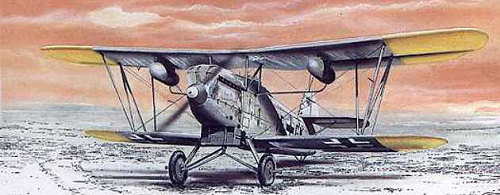 The
instruction sheet, divided into five assembly stages is easy to follow. The tiny
pieces that are contained in one wafer have the usual excessive but thin flash,
which with a little bit of care is easy to remove when separating the pieces.
The kit can be assembles as the type used for towing gliders which is displayed
on the box cover mentioned earlier. Alternatively it can be assembled as a green
camouflaged Arado with light blue undersurfaces. If one opts to do the tow-plane
version then one should study the clear illustration on the box cover to add the
details of the fuel supply pipe work and tiny side supporting struts attached to
the wing fuel tanks. Whereas the wing tanks are provided with the kit, the tiny
parts named are not, but can be made easily out of steel wire or stretched
sprue.
The
instruction sheet, divided into five assembly stages is easy to follow. The tiny
pieces that are contained in one wafer have the usual excessive but thin flash,
which with a little bit of care is easy to remove when separating the pieces.
The kit can be assembles as the type used for towing gliders which is displayed
on the box cover mentioned earlier. Alternatively it can be assembled as a green
camouflaged Arado with light blue undersurfaces. If one opts to do the tow-plane
version then one should study the clear illustration on the box cover to add the
details of the fuel supply pipe work and tiny side supporting struts attached to
the wing fuel tanks. Whereas the wing tanks are provided with the kit, the tiny
parts named are not, but can be made easily out of steel wire or stretched
sprue.
| CONSTRUCTION |
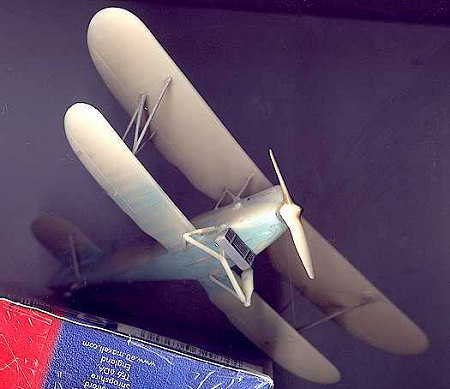 In
order to add strength to the resin struts, which are not normally reliably
strong as would be ones from Contrail, I decided to replace the two actuating
rods parts No 17, with two identical sewing pins of same diameter and cut to the
correct length. The resin wings are drilled with two blind tiny holes at the
exact place where these actuators are to be located. These will form locating
points for the exact position of the two pins, one on each wing. I used super
glue to fix these in place as I also did to fix the kit parts together. Once the
correct angle of the pins is achieved and set in place then I used cardboard
jigs that are cut to correct angle to obtain the right tilt for the outer wing
struts that should be slanting outwards towards the edge of the upper wing.
In
order to add strength to the resin struts, which are not normally reliably
strong as would be ones from Contrail, I decided to replace the two actuating
rods parts No 17, with two identical sewing pins of same diameter and cut to the
correct length. The resin wings are drilled with two blind tiny holes at the
exact place where these actuators are to be located. These will form locating
points for the exact position of the two pins, one on each wing. I used super
glue to fix these in place as I also did to fix the kit parts together. Once the
correct angle of the pins is achieved and set in place then I used cardboard
jigs that are cut to correct angle to obtain the right tilt for the outer wing
struts that should be slanting outwards towards the edge of the upper wing.
Interior detail is integrally moulded with the fuselage parts sides around the cockpit. A very small amount of putty was needed on the joint lines and wing joints. Final light sanding with wet and dry will smoothen these areas easily. This is definitely an impressive model and with the little amount of rigging needed turns this model into a fine replica of the real thing. This should be a very welcomed kit for those who are particularly keen on German Luftwaffe military aircraft.
| COLORS & MARKINGS |
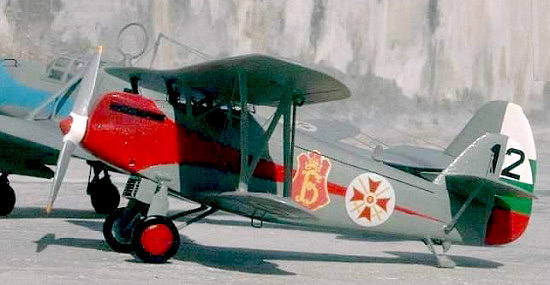 On the
other hand for those who, like me, seek fun in making German aircraft but in
foreign markings, it is just as easy to finish the model as one, which saw
service with the Royal Bulgarian Air Force. These carried the eight-pointed
Maltese cross style of markings and, at a later stage in their service life;
these took the form of cross of St. Andrew. In Bulgarian service the Arado were
finished in overall RLM02 grey, with a red tapering trim that ran the length of
the fuselage as seen in accompanying side view drawings. The King Boris cipher
was prominently displayed ahead of the fuselage Bulgarian markings. Incidentally
this is red and yellow and is identical in detail to that which was displayed on
the fin of the Dornier Do 11, which was also featured here some time earlier.
On the
other hand for those who, like me, seek fun in making German aircraft but in
foreign markings, it is just as easy to finish the model as one, which saw
service with the Royal Bulgarian Air Force. These carried the eight-pointed
Maltese cross style of markings and, at a later stage in their service life;
these took the form of cross of St. Andrew. In Bulgarian service the Arado were
finished in overall RLM02 grey, with a red tapering trim that ran the length of
the fuselage as seen in accompanying side view drawings. The King Boris cipher
was prominently displayed ahead of the fuselage Bulgarian markings. Incidentally
this is red and yellow and is identical in detail to that which was displayed on
the fin of the Dornier Do 11, which was also featured here some time earlier.
| ALTERNATIVE SUGGESTION |
Scratch building the Arado 65
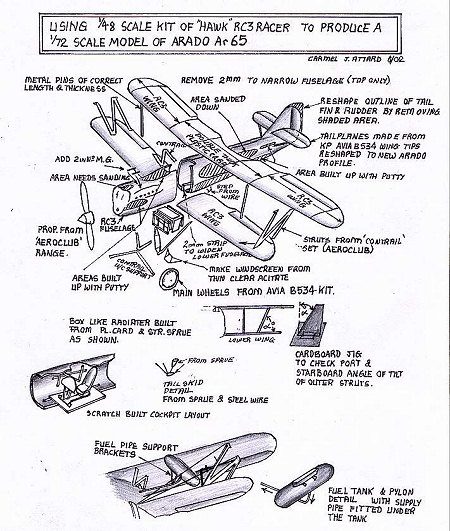 The
Arado 65 is an impressive biplane having a deep fuselage and interesting design.
In view of the different colour schemes that this trainer aircraft could carry,
particularly in Bulgarian service, I needed at least one more. Since my RS model
came a long way from a shop in the USA, another kit of it was far from being
readily available. As the Maltese saying goes “is-soppa tajba meta tikola
shuna” which translates into: “the soup is good to eat whilst it is still
hot”, I decided therefore not to wait but to improvise and make good with
whatever sources I have at my disposal. Living on a small island most of my life
nature taught me some ways to make good with whatever limited sources I could
find locally. Being further encouraged by the British saying that “necessity is
the mother of invention”, I decided to make a start on a model right away.
The
Arado 65 is an impressive biplane having a deep fuselage and interesting design.
In view of the different colour schemes that this trainer aircraft could carry,
particularly in Bulgarian service, I needed at least one more. Since my RS model
came a long way from a shop in the USA, another kit of it was far from being
readily available. As the Maltese saying goes “is-soppa tajba meta tikola
shuna” which translates into: “the soup is good to eat whilst it is still
hot”, I decided therefore not to wait but to improvise and make good with
whatever sources I have at my disposal. Living on a small island most of my life
nature taught me some ways to make good with whatever limited sources I could
find locally. Being further encouraged by the British saying that “necessity is
the mother of invention”, I decided to make a start on a model right away.
Looking through my scrap box, I soon recalled that I had a kit, which was discarded long ago, being 1/48th scale kit which it did not quite fit my range of 1/72 scale collection. This was the Hawk kit of the RC3 Racer. The only resemblance between these two aircraft was that their outline, particularly the engine configuration bore a fairly close resemblance. The broken up kit of the RC3 was retrieved from the junk box and a close comparison and study with a 1/72-scale plan of the Arado 65 indicated that the discarded model would surprisingly provide the basis for my second Arado 65.
I thought that readers might be interested in the kind of steps that I took to produce the second model of the Arado biplane. The accompanying drawing illustrated the various parts that make up the new kit and how these were produced. Reference can also be made to the accompanying photos that I have taken during the process of making the model.
| CONSTRUCTION |
 In
brief the steps involved in making my second Arado are as follows:
In
brief the steps involved in making my second Arado are as follows:
A) The fuselage of the RC3 Racer required an insert to add in order to broaden the section at the lower edge of the fuselage only, while a similar thickness of around 1.5 mm was reduced from the upper edge. In doing so I have produced a more uniform oval section as required for the Arado.
B) After careful study of the 1.72nd scale plans that I had, and also with measurement of the RS kit at my disposal, I shaped the front area of the fuselage by sanding off areas and adding putty to other places as required. An indication of these areas that needed attention is shown shaded on the accompanying sketch. Fortunately the old Hawk kit had thick plastic section and therefore the fuselage could take an appreciable amount of sanding without weakening the areas that needed reshaping, particularly to the rear of the fuselage and the tail fin and rudder, etc.
C) The fuselage was then cut vertically in two sections, immediately aft of the cockpit area. Checking the aft fuselage section against the scale plans showed the exact amount of excess fuselage required to be removed from the forward end of this section. The forward and rear sections of the fuselage were now joined and allowed to set and dry thoroughally. The great surprise is that the fuselage coincided perfectly well with the scale plans as shown in the photos.
 D)
The tail fin and rudder were marked in profile and
trimmed and shaped to conform to the characteristic Arado 65 outline.
D)
The tail fin and rudder were marked in profile and
trimmed and shaped to conform to the characteristic Arado 65 outline.
E) Six 1mm diameter holes were drilled on each side to form the exhaust ports. An engine starter hole was also drilled in the lower part of the engine on starboard side.
F) A rectangular and bulky radiator was built out of plastic card and as shown in the sketch. Other small fairings to the nacelle were shaped from sprue and added as per scale plans.
G) Two strut like actuators, as mentioned earlier were made out of steel pins, while the fuselage short struts and outer ‘N’- shaped struts were made out of Contrail struts supplied by Roll Models.
H) A square shaped footstep was added from thin steel wire and inserted in tiny pre drilled 0.4mm diameter holes in lower starboard fuselage in line with the cockpit.
I) An elongated fairing was built at the upper forward fuselage center, and just behind it, two MG guns were added out of sprue, cut to size. A tailskid was also added which was scratch built as shown in drawing.
J)
Fortunately the RC3 biplane wings were big enough
to produce the greater part of the lower and upper wings for the Arado. The
upper wings were made out of three main parts. The two outer sections came from
RC3 wings, after these were carefully shaped accordingly. The mid narrow section
was made out of laminated plastic card (in order to bring the required section
thickness), and a little anhedral was produced on the wing pieces when these
were fixed together to form the complete upper wing part. When these were
thoroughly dry, wing control surfaces were scribed as also the wing ribbing
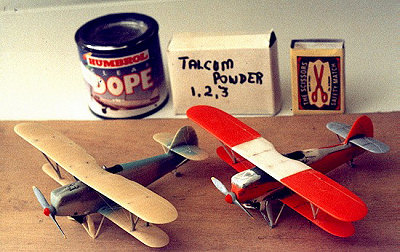 detail.
detail.
K) The lower wing was produced out of the lower RC3 wing pieces and detail scribed as required on them.
L) The cockpit interior was built out of plastic pieces to form the seat, column, rudder pedals, instrument panel, etc. The windshield was shaped from clear acetate sheet.
M) A left hand propeller came from the wide selection of Aeroclub range.
N) The tail planes were shaped out of wings of a KP Avia B534, which matched the right section and were further shaped with a file. The main wheels also came from the Avia B534 kit, as these were close in diameter and thickness.
Finally the parts were assembled and rigging added using invisible thread to conform with photos and drawings.
| COLORS & MARKINGS |
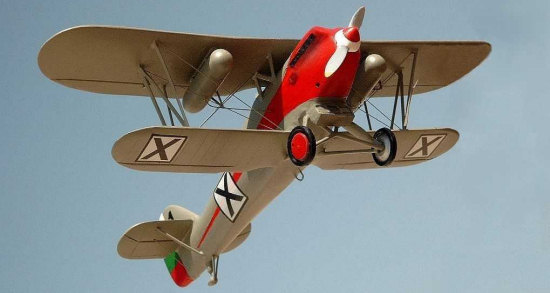 The
Arado 65 was to be finished in overall RLM02 grey. The red fuselage trim and the
three-colour rudder were first painted in Matt white undercoat, followed by two
coats of Humbrol red, green and white coat for the rudder. The trim was then
carefully masked as was also the rudder and the kit was given two coats of RLM02
rubbed down with fine wet and dry in between. The prewar R.Bulgarian AF insignia
came from Blue Rider sheet BR251, while those to produce the ’X’ insignia for
the second kit were built out of Microscale decal trim film white FS 37875 with
an X cross made from Xtradecals XPS-1 Black Strips. I am thankful to Dr Peter G.
Yanachkov of Bethesda USA, who was kind enough to supply me with King Boris III
cipher decal of correct size for my Arado models. The kit has since been issued
by RS models in this style of Bulgarian AF markings.
The
Arado 65 was to be finished in overall RLM02 grey. The red fuselage trim and the
three-colour rudder were first painted in Matt white undercoat, followed by two
coats of Humbrol red, green and white coat for the rudder. The trim was then
carefully masked as was also the rudder and the kit was given two coats of RLM02
rubbed down with fine wet and dry in between. The prewar R.Bulgarian AF insignia
came from Blue Rider sheet BR251, while those to produce the ’X’ insignia for
the second kit were built out of Microscale decal trim film white FS 37875 with
an X cross made from Xtradecals XPS-1 Black Strips. I am thankful to Dr Peter G.
Yanachkov of Bethesda USA, who was kind enough to supply me with King Boris III
cipher decal of correct size for my Arado models. The kit has since been issued
by RS models in this style of Bulgarian AF markings.
Still if one prefers to do a warlike scheme, an olive green upper with sky blue lower surfaces was also used to the Bulgarian Arado 65. This had ‘X’ insignia in six positions while the rudder was also painted in red and green Bulgarian colours. The propellers for the two kits I built were identically painted in light grey with yellow tips and the hub was white with a red center.
| CONCLUSIONS |
 These
two models offered a real challenge particularly the ‘scratch built’ one and the
end result encouraged me to go for more unorthodox aircraft types that were in
service with the Bulgarian AF.
These
two models offered a real challenge particularly the ‘scratch built’ one and the
end result encouraged me to go for more unorthodox aircraft types that were in
service with the Bulgarian AF.
March 2007
If you would like your product reviewed fairly and fairly quickly, please contact the editor or see other details in the Note to Contributors.